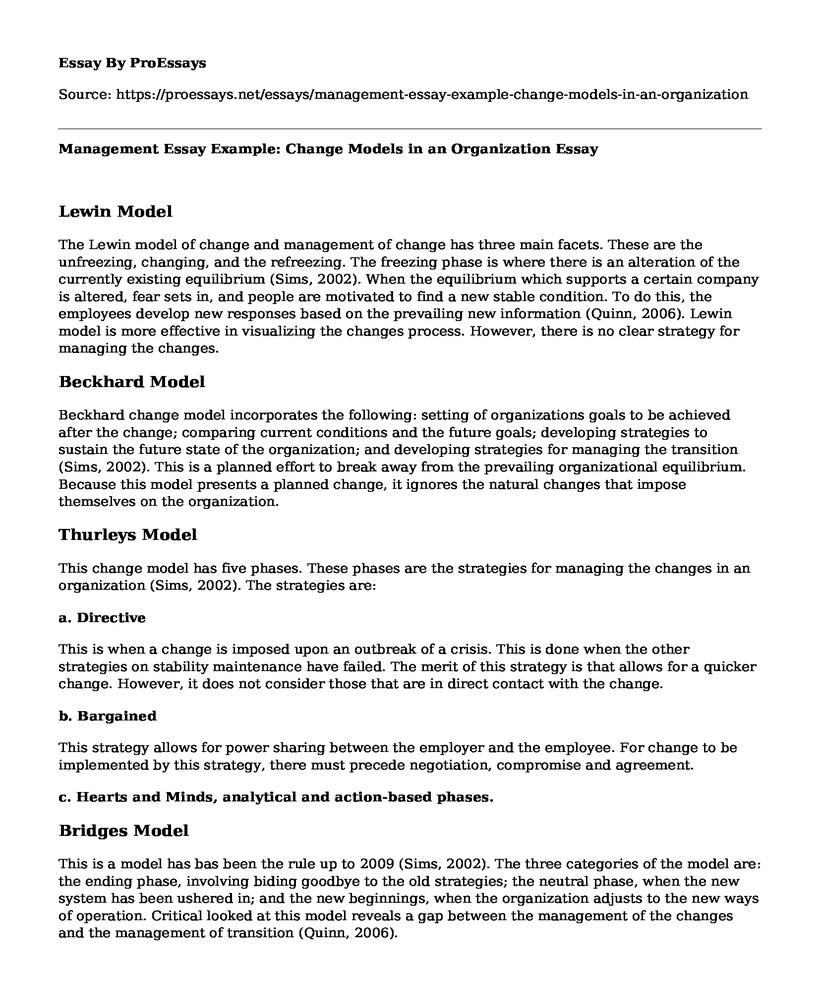Lewin Model
The Lewin model of change and management of change has three main facets. These are the unfreezing, changing, and the refreezing. The freezing phase is where there is an alteration of the currently existing equilibrium (Sims, 2002). When the equilibrium which supports a certain company is altered, fear sets in, and people are motivated to find a new stable condition. To do this, the employees develop new responses based on the prevailing new information (Quinn, 2006). Lewin model is more effective in visualizing the changes process. However, there is no clear strategy for managing the changes.
Beckhard Model
Beckhard change model incorporates the following: setting of organizations goals to be achieved after the change; comparing current conditions and the future goals; developing strategies to sustain the future state of the organization; and developing strategies for managing the transition (Sims, 2002). This is a planned effort to break away from the prevailing organizational equilibrium. Because this model presents a planned change, it ignores the natural changes that impose themselves on the organization.
Thurleys Model
This change model has five phases. These phases are the strategies for managing the changes in an organization (Sims, 2002). The strategies are:
a. Directive
This is when a change is imposed upon an outbreak of a crisis. This is done when the other strategies on stability maintenance have failed. The merit of this strategy is that allows for a quicker change. However, it does not consider those that are in direct contact with the change.
b. Bargained
This strategy allows for power sharing between the employer and the employee. For change to be implemented by this strategy, there must precede negotiation, compromise and agreement.
c. Hearts and Minds, analytical and action-based phases.
Bridges Model
This is a model has bas been the rule up to 2009 (Sims, 2002). The three categories of the model are: the ending phase, involving biding goodbye to the old strategies; the neutral phase, when the new system has been ushered in; and the new beginnings, when the organization adjusts to the new ways of operation. Critical looked at this model reveals a gap between the management of the changes and the management of transition (Quinn, 2006).
Kotter Model
This is one of the most recent models of change in an organization. Kotter lists eight things that successful managers do in order to realize effective organizational change (Kotter, 2002). These are: establishing sense of urgency; forming guiding coalition; creating vision; communicating the vision; empowering other for the vision; creating short term wins; producing still more changes; and institutionalizing the new approaches.
The challenge with the model is that it assumes that changes come at once and the mute (Sims, 2002). It is also easy for employees to lose trust in the organization due to unfair pressure change.
Role of Leader Vision in Organization
Leaders are significant in an organization for communicating the and promoting the vision of the institution. Since the visions drive the institution, the visionary leader is a precious asset to the organization (Sims, 2002). This is because he or she is expected to read the map for the future destination of the company. Employees can trust their job security with a clear-visional leader.
Change and Performance
A never-changing work environment becomes boring. Still further, it sets the organization into a pathway of downfall. When situations demand, it is necessary to break off from a particular system and create another exciting one for the employees. Planned changes usually motivate the employees to improve in their performance (Quinn, 2006).
References
Sims, R. R., (2002). Changing the Way, We Manage Change. Westport, Conn Quorum Books
Kotter, J. P., (2002). The Heart of Changes: Real Life Stories. Harvard Business School. Boston
Quinn, J. B., (2006). Organizational Development, Change and transformation: Handbook of Human Resource Management. Cambridge University Press. London
Cite this page
Management Essay Example: Change Models in an Organization. (2021, Apr 15). Retrieved from https://proessays.net/essays/management-essay-example-change-models-in-an-organization
If you are the original author of this essay and no longer wish to have it published on the ProEssays website, please click below to request its removal:
- Dissrtation Methodology on Company's Organisational Culture
- Proper Planning of Hairdresser Business Essay
- Multichannel Digital Marketing for Nike Paper Example
- Paper Example on Governance: Key to Country's Success
- Essay Sample on Empowering Leadership: Deciding the Acting Chair Through Different Types of Power
- Leadership Qualities: Essential for Achieving Organizational Goals - Essay Sample
- Lesson Learned: Most Valuable for Future Performance - Paper Sample







